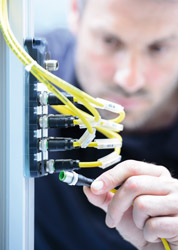
Posted to News on 16th Jul 2015, 09:18
IP67 cable connections and more efficient machine building
Graham Traill, the System Solutions and Technical Projects Manager at Murrelektronik Ltd, discusses the IP67 trend and machine efficiency.

1. Only a few years ago, a large growth was expected for field wiring with IP67 components. Have these expectations been met, and what is your opinion regarding the current and mid-term development?
Our expectations in this area have been met. At Murrelektronik we see a big potential in this market to produce machines more efficiently. More and more companies are realising the possible savings by switching over to IP67 components. Conventional parallel wiring with junction boxes in the field requires expert knowledge and a lot of patience. Stripping wires, crimping ferrule ends and connecting single wires to terminal boxes takes up to two minutes per terminal point. IP67 components with M8 and M12 connection enable significantly faster setup, offer better diagnostics, a clear system structure and a low risk of failure. The time required from the installation up to the implementation can be reduced by up to 80 per cent - this is an advantage for machine and system builders who often have to deal with time pressure. Additional benefits include more space in the control panel and easier to expand systems.
2. Fieldbus boxes and complete I/O systems with IP67 in different versions and models are available. However, are there also IP67 power supplies or power bus systems and components available for drive controls? What is the demand for the individual devices in your opinion?
We solved the problem of supplying power in the field with Emparro67, an IP67 power supply unit that is especially designed for field applications. When using 24V DC power supplies line losses can occur with long cable runs, as an example with conveyors applications. By using Emparro67 power supplies the voltage is converted from 230V AC to 24V DC directly at the load. By doing this, the power loss is much lower and energy costs are reduced. Installing the power supply units outside the cabinet by using Emparro67 offers other benefits: control panels can be reduced in size and in some applications it is possible to completely eliminate the need for control panels.
However, we are also aware that the IP67 plug-and-play concept cannot be implemented in all applications because there is still unrealised potential especially in the area of drive controls.
Completely moulded M23 connectors to connect servo motors are a step in this direction. Today many connections are still field wired; this can result in miss-wiring and bad cable sealing, leading to a high risk of failure.
3. IP67 was designed to reduce wiring in the control panel and provide more connectivity in the field. Which IP67 components are currently preferred, what are the usual applications and how are they usually put into practice?
With I/O wiring, most of the requirements are certainly met; this can be seen from the fact that there are almost no applications or industries where they are not used. Decentralisation creates flexibility in the mechanical modularisation of the system, signals can be connected at the position where they are created this significantly reduces the wiring and the time it takes. With Connectivity by Murrelektronik, our consulting brand, we actively support our customers in finding the right installation option.
Pre-wired valve connectors and connection cables significantly reduce the wiring effort and risk of failure. The first step into decentralised IP67 installations is usually made by adopting passive distribution boxes these collect signals and transfer them into the control cabinet with a multi-core cable. If you go one step further and install a fieldbus system the need to terminate field wiring at the control panel is eliminated.
With pre-made and pre-tested connector leads the connection of devices to the I/O modules is consistent, the I/O modules provides comprehensive diagnostic options. Whether compact modules or modular fieldbus systems are used depends on the application, the customer requirement and the number of IO points. For smaller systems (usually less than 30 I/O points), active fieldbus technology is not economical.
4. For IP20 fieldbus systems, the current discussion about cycle rates and transfer rates, especially in connection with Industrial Ethernet, is very interesting. Does this discussion also play a role for IP67 field wiring?
Of course, performance is an important issue for IP67 field wiring, because the same functions are controlled whether the I/O is IP20 or IP67. A large number of simple sensors and actuators do not require the currently discussed high cycle rates.
To learn more about IP67 connections and machine efficiency go to www.murrelektronik.co.uk.
5 Albion Street, Pendlebury Industrial Estate
Swinton
M27 4FG
UNITED KINGDOM
+44 (0)161 728 3133






























